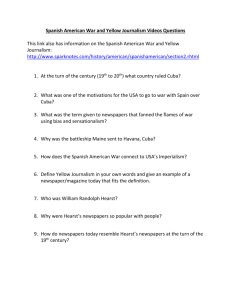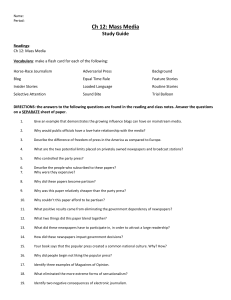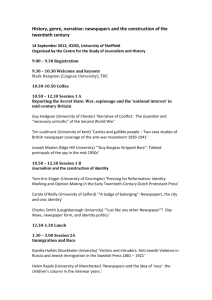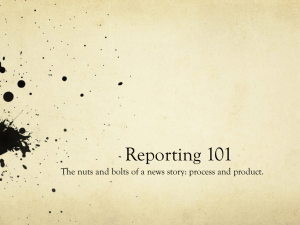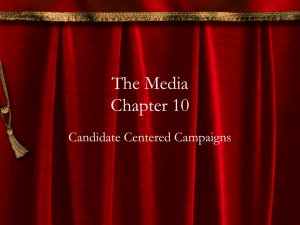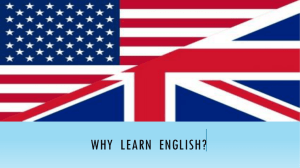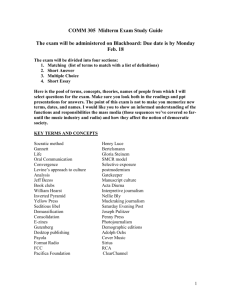The History of Journalism PowerPoin
advertisement
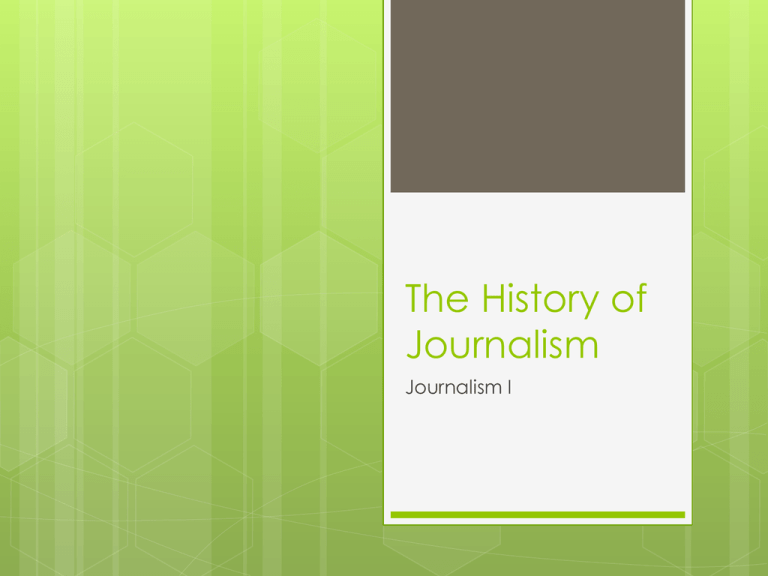
The History of Journalism Journalism I BBBOOORRRIINNNGGGG America’s First Newspapers The first attempt, Publick Occurrences, was published in Boston in 1690 by Benjamin Harris. After only one issue, the British colonial authorities suppressed the paper because they didn’t like what Harris printed. Later, the colonies had their first continuously published newspaper: the Boston News-Letter, started by John Campbell in 1704. It was published by “authority,” meaning it had the government’s approval. “Were it left to me to decide whether we should have a government without newspapers or newspapers without a government, I should not hesitate to prefer the latter.” - Thomas Jefferson The Birth of the Nation By 1775, when the Revolution began, 37 newspapers were being published. These newspapers generally allied themselves with the patriots, at least partly because of their anger over the Stamp Act, which imposed a tax on periodicals. They backed the Revolution and printed the cries to battle that rallied the rebels. The First Amendment, ratified in 1791, guarantees a free press with the words “Congress shall make no law… abridging the freedom of speech, or of the press. The Birth of a Nation After the Revolution, the young nation grew rapidly, and so did the newspaper industry. Hundreds of newspapers opened up all over the new land. The first daily, the Pennsylvania Post, was founded in 1783. The first student newspaper, the Students Gazette, was founded even earlier at the Friends Latin School in Pennsylvania, in 1777. This paper was handwritten by students. The Penny Press Early newspapers carried little actual news. They were filled largely with opinions in the form of essays, letters, and editorials, plus a few advertisements. Then in 1833, Benjamin Day founded the New York Sun, filled it with news, and sold it for only a penny. Day’s staff covered the police beat, wrote about tragedies and natural disasters, and toned down the opinions. Thus was born the “penny press.” The Penny Press Because it was so inexpensive and distributed by street sales rather than subscription, the penny press achieved a mass audience. With such a large audience, advertising took on a major role. Two years later James Gordon Bennett started the New York Morning Herald. Even though it sold for two cents, it continued the newsy ways of the Sun. One of the most influential penny presses was the New York Tribune, founded in 1841 by social reformer Horace Greeley. Yellow Journalism Yellow journalism is a term that refers to an unethical, irresponsible brand of journalism involving hoaxes, altered photographs, screaming headlines, “scoops,” frauds, and endless self-promotions by the papers. It reached its peak in the later 1800s. William Randolph Hearst, publisher of the New York Journal, and Joseph Pulitzer, publisher of the New York World, are the most notable users of yellow journalism. The Spanish-American War Around 1895, a movement began in Cuba to seek independence from Spain. The World and the Journal whipped up a war climate in support of the Cuban nationalists and tried to lure the US into the conflict. While the press was not solely to blame for the war, the yellow journalism of the time certainly contributed to an atmosphere of suspicion and conflict. One story is about a Journal artist in Cuba who cabled Hearst that there was no war and that he was coming home. Hearst wired back, “Please remain. You furnish the pictures, and I’ll furnish the war.” Nellie Bly Nellie Bly was the named used by Elizabeth Cochrane, the most famous of the women journalists beginning to make names for themselves. Bly worked for Pulitzer’s World and was noted for her “stunts,” stories in which she made the news herself. She was willing to travel anywhere to get (or create) a story. She pretended to be ill and was committed to New York’s Blackwell Island Asylum. Released 10 days later, she wrote a story exposing the asylum’s poor conditions. She set out of circle the globe in fewer than 80 days, to test Jules Verne’s book, Around the World in Eighty Days. She did it – in 72 days. Muckraking The end of yellow journalism ushered in a period during which American newspapers developed a significant social consciousness. Many papers crusaded for child labor laws, promoted hospitals and tuberculosis sanitariums, collected money for the needy, the status of African Americans, and the meat-packing industry. The Pure Food and Drugs Act of 1906 grew out of the crusades, as did many other reforms. Ida Tarbell’s series on “The History of the Standard Oil Company” in McClure’s was one of the first attacks on big business. Minority Media The Chicago Defender, one of the nation’s largest and most influential African American newspapers, was founded in 1905 by Robert S. Abbott, whose parents had been slaves. The Defender became a daily in 1956 under Abbott’s nephew, John H. Sengstacke, who built a large chain of African American newspapers. Ebony has been in circulation since 1945. Essence and Black Enterprise, though newer exhibit similar staying power. Two of the largest Hispanic American newspapers are El Diario-La Prensa in NYC and Diario Los Americas in Miami. The first Native American newspaper was the Cherokee Phoenix in 1828, but it was shut down by the government five years later for publishing ideas seen as antigovernment. Today the independent Lakota Times is prominent because of its famous Native American publisher and journalist, Tim Giago. The Advent of Radio In 1906 Dr. Lee De Forest made improvements in the vacuum tube that made possible the new medium of radio. De Forest then made the first newscast in 1916, when he broadcast presidential elections returns over a limited area. Regular daily programs started in Detroit in 1920. The National Broadcasting Company (NBC) was formed in 1926, the Columbia Broadcasting System (CBS) in 1927, and the American Broadcasting Company (ABC) in 1945. The Radio Act of 1927 broadened the power of assigning wavelengths and license applicants by creating the Federal Radio Commission. Today’s Federal Communications Commission (FCC) has jurisdiction, though not censorship power, over both radio and television. There are now over 5,000 FM stations. The Impact of Television The first television newscast took place in the late 1940s. Early television pictures were snowy, and transmission facilities were erratic. Both color and sound quickly improved. By the mid 1960s, more than 60 million TV sets were in use. Thirty years later, the number exceeded 90 million. Always sensitive to criticism and the possibility of lower ratings, television news seems to be examining its practices as never before. The Effects of Technology The Internet was the last great media advance of the 20th century. It has made the transmission of information both amazingly quick and exceedingly efficient. Internet came into popular use in the early 1990s, when commercial services made access to it available to anyone with a computer and modem. The internet has changed the ways news is presented and read. Today readers may continue until they find a link that interests them, at which point they leave the original story, and go looking for related information, sometimes from a different source. The Future of Journalism http://youtu.be/RuBE_dP900Y Research Project Pick a famous journalist or publisher from the list. If you pick one and you end up hating them, you may choose one more time, but then that’s it! Research the person. Why are they famous? What were they responsible for? Do they have a good or bad reputation? You will do a public presentation about your person. You must have some form of visual to accompany your speech. Examples: PowerPoint, Prezi, poster board, and more

